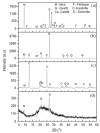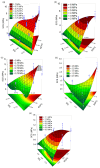Compositional Design of New Environmentally Friendly Geopolymer Mortar Based on Kaolin and Granite Residues
- PMID: 39597433
- PMCID: PMC11595492
- DOI: 10.3390/ma17225610
Compositional Design of New Environmentally Friendly Geopolymer Mortar Based on Kaolin and Granite Residues
Abstract
The use of industrial residues in civil construction is an exciting alternative to mitigate environmental impacts and promote the circular economy. This work developed new compositions of geopolymer mortars activated by NaOH from fine kaolin residue (RCF), coarse kaolin residue (RCG) and granite (RG). All residues were benefited and characterized by chemical analysis (X-ray fluorescence), mineralogical phases (X-ray diffraction) and granulometry (laser granulometry). Additionally, the RCF was calcined at 650 °C for 2 h (RCFC) to produce metakaolin, which is the starting point for the geopolymer reaction. A mixture of experimental designs was accomplished to evaluate the water/binder factor (Wexp (%)) necessary for new geopolymer mortar compositions to reach the consistency index (260 mm, ASTM C1437-15) and the effect of different curing conditions on the simple compressive strength (SCS). The geopolymeric compositions with RCFCs, pre-cured at room temperature, exhibited the highest Wexp% values (>40%) and significant SCS, with curing conditions A and B reaching 6 MPa and 7 MPa, respectively. Such behavior can be explained by the fact that the pre-curing step at room temperature keeps the system humidity relatively high, favoring the dissolution of Si4+ and Al3+ ions and, therefore, increasing the Si/Al ratio, which positively influences the geopolymerization kinetics reaction.
Keywords: environmentally friendly materials; geopolymer mortar compositions; geopolymerization; granite residues and circular economy; kaolin residues; sustainable materials.
Conflict of interest statement
The authors declare no conflicts of interest.
Figures




References
-
- Raut S.P., Ralegaonkar R.V., Mandavgane S.A. Development of Sustainable Construction Material Using Industrial and Agricultural Solid Waste: A Review of Waste-Create Bricks. Constr. Build. Mater. 2011;25:4037–4042. doi: 10.1016/j.conbuildmat.2011.04.038. - DOI
-
- Alsheyab M.A.T. Recycling of Construction and Demolition Waste and Its Impact on Climate Change and Sustainable Development. Int. J. Environ. Sci. Technol. 2022;19:2129–2138. doi: 10.1007/s13762-021-03217-1. - DOI
-
- Alengaram U.J. Valorization of Industrial Byproducts and Wastes as Sustainable Construction Materials. In: Colangelo F., Cioffi R., Farina I., editors. Handbook of Sustainable Concrete and Industrial Waste Management. Elsevier; Amsterdam, The Netherlands: 2022. pp. 23–43.
-
- Zainal F.F., Hussin F.W.M., Nordin M.N., Hastuty S. The Effect of Curing Temperature on the Properties of Kaolin Geopolymer Paste. J. Phys. Conf. Ser. 2022;2169:012029. doi: 10.1088/1742-6596/2169/1/012029. - DOI
Grants and funding
LinkOut - more resources
Full Text Sources

